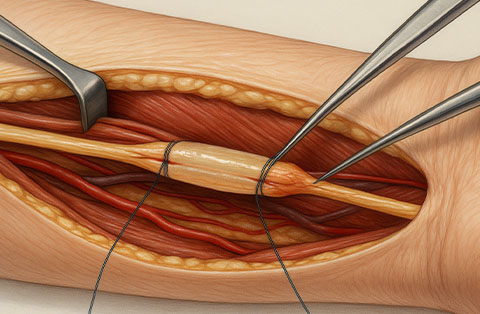Mentoplasty, often referred to as chin surgery, is a transformative cosmetic procedure that reshapes the chin to enhance facial harmony.
This surgical technique can involve either augmenting a receding chin with implants or reducing an overly prominent chin to create a more balanced profile. By adjusting the chin's size and shape, mentoplasty can significantly impact one's appearance and self-esteem.
Whether you're considering this procedure to improve facial asymmetry, address congenital anomalies, or simply boost your confidence, understanding the surgical options, risks, and expected outcomes is crucial.
In this article, we'll explore the nuances of mentoplasty, including innovative techniques, recovery processes, and real-life transformations to help you make an informed decision about undergoing chin surgery.
What is Mentoplasty?
Mentoplasty, or chin surgery, modifies the shape of the chin to improve facial balance. Surgeons perform this procedure either by enhancing a small chin with implants or by reducing an oversized chin. This adjustment can address issues like facial asymmetry or congenital differences, enhancing the overall aesthetic and symmetry of the face.
The surgery aims to boost confidence and improve the proportionality of facial features. It involves precise techniques tailored to individual needs, ensuring that the results align with the patient's cosmetic goals. Recovery varies, but patients typically see the outcome once swelling subsides.
What is Sliding Mentoplasty?
Sliding mentoplasty is a type of chin surgery that adjusts the bone for better facial balance. In this procedure, surgeons make a cut in the jawbone, allowing them to slide the chin forward or backward.
This technique is ideal for correcting more significant chin misalignments or asymmetries. It offers customizable changes, unlike implants that provide predefined shapes and sizes.
The surgery aims to enhance facial harmony and improve the jawline's appearance. Recovery includes managing swelling and ensuring the bone heals correctly in its new position. Sliding mentoplasty can make a dramatic difference in a person’s profile and confidence.
Mentoplasty vs Genioplasty
Mentoplasty and genioplasty are surgical procedures aimed at enhancing the chin's appearance, but they differ slightly in scope and technique. Mentoplasty generally refers to any cosmetic surgery that modifies the chin's size or shape, often using implants.
Genioplasty, specifically, is a form of mentoplasty that involves surgical alterations to the chin bone, such as cutting and repositioning it, to correct functional and aesthetic concerns.
Here's a detailed comparison chart:
Aspect | Mentoplasty | Genioplasty |
Definition | Cosmetic modification of the chin. | Type of mentoplasty focusing on bone structure. |
Techniques | Uses implants or chin reduction. | Involves bone cutting and repositioning. |
Purpose | Enhances chin size and shape. | Corrects functional and aesthetic issues. |
Recovery | Varies based on procedure complexity. | Generally longer due to bone healing. |
Outcome | Cosmetic improvement in chin appearance. | Functional and aesthetic improvement. |
Customization | Limited by implant shapes and sizes. | Highly customizable, tailored to patient needs. |
This chart highlights the key differences between mentoplasty and genioplasty, helping patients choose the right procedure based on their specific needs.
The Mentoplasty Procedure
Examining the Steps of a Typical Mentoplasty Surgery
A typical mentoplasty surgery involves several key steps.
First, the surgeon evaluates the patient’s facial structure to determine the necessary adjustments.
Next, under general anesthesia, the surgeon makes an incision, usually inside the mouth to conceal scars.
For chin enhancement, they may insert an implant or, in reduction cases, remove excess bone. In procedures involving bone, the plastic surgeon might cut and reposition the chin bone to improve alignment.
After reshaping, they secure the new structure with plates and screws if needed.
Finally, they close the incision and apply bandages. Recovery involves managing swelling and discomfort while the chin heals into its new shape.
The Role of Implants in Chin Augmentation
Implants play a crucial role in chin augmentation, a popular method for enhancing the chin's prominence and improving facial harmony.
Surgeons select implants based on the desired outcome, fitting them to augment the bone structure effectively. They typically make a small incision under the chin or inside the mouth, inserting the implant directly along the bone.
This process allows for significant yet natural-looking changes to the chin's appearance. Implants are made from biocompatible materials, ensuring safety and reducing the risk of rejection. The result is a more defined jawline and improved balance among facial features, boosting the patient’s confidence.
Mentoplasty Recovery Timeline and Tips for a Smooth Healing
Mentoplasty recovery follows a structured timeline. Immediately after surgery, patients experience swelling and discomfort, managed with pain medication.
The first week involves resting and applying ice packs to reduce swelling. Stitches, if external, are typically removed within a week.
By the end of the second week, major swelling subsides, allowing most patients to return to non-strenuous activities.
Full recovery and final results become visible around the six-week mark, though minor swelling can persist for a few months. Patients must avoid rigorous activities during the initial recovery phase to ensure proper healing and the best possible outcome from their chin surgery.
Here are some tips for a smooth healing process after mentoplasty:
Follow Post-Op Instructions: Adhere strictly to the surgeon's aftercare guidelines to avoid complications.
Cold Compresses: Regularly apply ice packs or cold compresses to reduce swelling and bruising.
Elevate Your Head: When resting or sleeping, keep your head elevated above your heart to minimize swelling.
Avoid Strenuous Activities: Limit physical activity, especially anything involving heavy lifting or high impact, for the first few weeks.
Maintain Oral Hygiene: If the incision is inside the mouth, gently rinse with saline or prescribed mouthwash to prevent infection.
Nutritious Diet: Eat a healthy diet rich in vitamins and minerals to aid the healing process. Opt for soft foods if chewing is painful.
Stay Hydrated: Drink plenty of water to stay hydrated, which is crucial for recovery.
Avoid Smoking and Alcohol: Smoking can impede blood flow and slow healing, while alcohol can increase swelling.
Attend Follow-up Visits: Go to all scheduled post-operative appointments to ensure proper healing and address any concerns.
Use Pain Medication as Directed: Manage pain and discomfort with medications as prescribed by your surgeon, avoiding over-the-counter medications without approval.
Following these tips can help ensure a smoother and quicker recovery from mentoplasty.
Combining Mentoplasty with Other Facial Plastic Surgery Procedures
Combining mentoplasty with other facial surgeries can enhance overall results. Procedures like rhinoplasty or facelifts often accompany mentoplasty for comprehensive facial balance. This approach ensures proportional and harmonious features. Patients benefit from a single recovery period for multiple corrections, reducing overall downtime. Consult a skilled surgeon to determine the best combination of procedures for your aesthetic goals.
Enhancing Facial Harmony: Mentoplasty and Rhinoplasty
Enhancing facial harmony often involves combining mentoplasty with rhinoplasty. Mentoplasty reshapes the chin while rhinoplasty adjusts the nose, balancing the facial profile effectively.
This combination addresses the relationship between the nose and chin, which is crucial for facial symmetry. When the chin is proportionate to the nose, it creates a more pleasing aesthetic. Patients see significant improvements in their overall appearance, achieving a more balanced and attractive look.
Addressing Facial Asymmetry: The Role of Chin Surgery
Chin surgery plays a vital role in addressing facial asymmetry, a common aesthetic concern. By modifying the chin's shape or size, surgeons can dramatically improve facial balance. Techniques like implant insertion or bone reshaping help align the chin with other facial features, creating symmetry.
This adjustment not only enhances the lower face but also influences the overall harmony of the facial structure. Patients considering chin surgery for asymmetry should discuss options with a skilled surgeon to choose the most effective approach. This targeted intervention can boost confidence and result in a more proportionate and pleasing facial appearance.
Mentoplasty Cost
Mentoplasty cost varies depending on the complexity of the procedure and geographic location. Typically, prices range from $3,000 to $7,000.
This cost can increase if combined with other surgeries such as rhinoplasty. Always confirm the total cost, which should include the surgeon's fee, anesthesia, facility fees, and post-operative care, with your healthcare provider before proceeding.
Does Insurance Cover Mentoplasty?
Insurance typically does not cover mentoplasty if it is performed for cosmetic reasons. However, if the procedure is necessary for medical reasons, such as correcting a congenital anomaly or a functional impairment, insurance may provide coverage. It is important to consult with your insurance provider and obtain pre-approval to determine if your specific circumstances qualify for insurance coverage.
Comparing Costs: Mentoplasty in Your Home Country vs Abroad
Mentoplasty costs can differ widely between your home country and abroad. Countries like Turkey typically offer mentoplasty at lower prices due to economical healthcare costs, while maintaining international healthcare standards. In contrast, countries like the USA and those in Western Europe, such as the UK and Germany, generally have higher prices due to more stringent regulatory standards and higher operational costs.
Here’s a detailed comparison chart of Mentoplasty Surgery Cost with average price ranges in Euros:
Country | Average Cost in Euros |
Turkey | €1,500 - €3,000 |
UK | €4,500 - €7,000 |
France | €4,000 - €6,000 |
Germany | €4,000 - €6,500 |
USA | €5,000 - €8,000 |
Italy | €3,500 - €6,000 |
Spain | €3,000 - €5,500 |
These figures reflect a range of costs, including the surgeon’s fees, facility fees, and anesthesia, but they can vary based on the specific details of the procedure and the clinic’s reputation.
Mentoplasty Before and After

Mentoplasty dramatically transforms your chin's appearance, enhancing facial harmony. Before the procedure, patients often feel their chin does not complement their facial features. After mentoplasty, they notice a balanced, proportionate look. This change can significantly boost self-esteem and confidence.
Below, explore our before and after photo gallery to see the impactful results mentoplasty can achieve, showcasing real patient transformations.
Risks and Complications
Mentoplasty, like any surgery, carries risks and potential complications. Common issues include infection, scarring, and adverse reactions to anesthesia. Patients might also experience numbness or changes in chin sensation, which are typically temporary. More serious complications can include implant misalignment or bone shifting, which might require further surgery to correct. It's important for patients to discuss these risks thoroughly with their surgeon to make informed decisions.
Frequently Asked Questions
What age can you get a mentoplasty?
You can get mentoplasty once your facial bones have fully matured, typically around the age of 18. For younger paitents, it's crucial to wait until this age to ensure stable and safe results. Always consult with a qualified surgeon to discuss the best timing.
Is mentoplasty permanent?
Yes, mentoplasty is generally permanent. The changes made to the chin's structure or the placement of implants are designed to last a lifetime. However, like any surgical result, factors such as aging and lifestyle can influence long-term outcomes.
Can you fix your chin without surgery?
Yes, you can improve chin appearance without surgery using injectable fillers or fat grafting. These non-surgical methods can enhance chin contour and balance facial features temporarily. Results vary but typically last from several months to a couple of years, depending on the treatment chosen.
How Much does Mentoplasty Cost in Turkey?
Mentoplasty costs in Turkey range from €1,500 to €3,000. These costs are generally lower compared to Western countries, making Turkey a popular destination for this surgery. Prices include surgeon's fees, facility charges, and anesthesia, but can vary based on clinic and procedure specifics.






